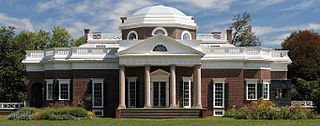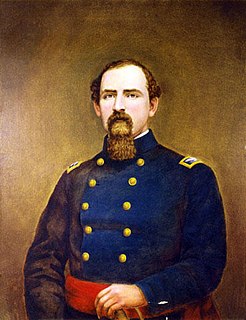Hemings is a surname, and may refer to:

Monticello was the primary plantation of Thomas Jefferson, the third president of the United States, who began designing Monticello after inheriting land from his father at age 26. Located just outside Charlottesville, Virginia, in the Piedmont region, the plantation was originally 5,000 acres (20 km2), with Jefferson using the labor of enslaved African people for extensive cultivation of tobacco and mixed crops, later shifting from tobacco cultivation to wheat in response to changing markets. Due to its architectural and historic significance, the property has been designated a National Historic Landmark. In 1987, Monticello and the nearby University of Virginia, also designed by Jefferson, were together designated a UNESCO World Heritage Site. The current nickel, a United States coin, features a depiction of Monticello on its reverse side.

Sarah "Sally" Hemings was an enslaved quadroon woman owned by President of the United States Thomas Jefferson, one of many he inherited from his father-in-law, John Wayles.

"Children of the plantation" was a euphemism used during the time of slavery in the United States, to identify the offspring born to black female slaves and white men, usually the slave's owner, one of the owner's relatives, or the plantation overseer. Rape of female slaves was common on plantations. These children were born into slavery, through a legal doctrine known as partus sequitur ventrem. They were classified as mulattoes, a former term for a multiracial person. The one drop rule meant that they could never be part of white society. Some of the fathers treated these children well, sometimes providing educational or career opportunities, or manumitting (freeing) them. Examples are Archibald and Francis Grimké, and Thomas Jefferson's children by Sally Hemings. Others treated their multiracial children as property; Alexander Scott Withers, for instance, sold two of his children to slave traders, where they were sold again.

Clotel; or, The President's Daughter: A Narrative of Slave Life in the United States is an 1853 novel by United States author and playwright William Wells Brown about Clotel and her sister, fictional slave daughters of Thomas Jefferson. Brown, who escaped from slavery in 1834 at the age of 20, published the book in London. He was staying after a lecture tour to evade possible recapture due to the 1850 Fugitive Slave Act. Set in the early nineteenth century, it is considered the first novel published by an African American and is set in the United States. Three additional versions were published through 1867.
Eston Hemings Jefferson was born into slavery at Monticello, the youngest son of Sally Hemings, a mixed-race enslaved woman. Most historians who have considered the question believe that his father was Thomas Jefferson, the third President of the United States. Evidence from a 1998 DNA test showed that a descendant of Eston matched the Jefferson male line, and historical evidence also supports the conclusion that Thomas Jefferson was probably Eston's father. Many historians believe that Jefferson and Sally Hemings had six children together, four of whom survived to adulthood.

Partus sequitur ventrem was a legal doctrine passed in colonial Virginia in 1662 and other English crown colonies in the Americas which defined the legal status of children born there; the doctrine mandated that all children would inherit the legal status of their mothers. As such, children of enslaved women would be born into slavery. The legal doctrine of partus sequitur ventrem was derived from Roman civil law, specifically the portions concerning slavery and personal property (chattels).
The Jefferson–Hemings controversy was a historical debate over whether there was a sexual relationship between the widowed U.S. President Thomas Jefferson and his slave and sister-in-law, Sally Hemings, and whether he fathered some or all of her six recorded children. For more than 150 years, most historians denied rumors from Jefferson's presidency that he had a slave concubine. Based on his grandson's report, they said that one of his nephews had been the father of Hemings' children. Before changing his mind following the results of DNA analysis in 1998, Jefferson biographer Joseph J. Ellis had said, "The alleged liaison between Thomas Jefferson and Sally Hemings may be described as the longest-running miniseries in American history." In the 21st century, most historians agree that Jefferson is the father of one or more of Sally's children.

Thomas Jefferson is a 1997 two-part American documentary film directed and produced by Ken Burns. It covers the life and times of Thomas Jefferson, the 3rd President of the United States.
Madison Hemings was the son of the mixed-race enslaved woman Sally Hemings and her owner, President Thomas Jefferson. He was the third of her four children to survive to adulthood. Born into slavery, according to partus sequitur ventrem, Hemings grew up on Jefferson's Monticello plantation, where his mother was enslaved. After some light duties as a young boy, Hemings became a carpenter and fine woodwork apprentice at around age 14 and worked in the Joiner's Shop until he was about 21. He learned to play the violin and was able to earn money by growing cabbages. Jefferson died in 1826, after which Sally Hemings was "given her time" by Jefferson's surviving daughter Martha Jefferson Randolph.
Mary Hemings Bell,, was born into slavery, most likely in Charles City County, Virginia, as the oldest child of Elizabeth Hemings, a mixed-race slave held by John Wayles. After the death of Wayles in 1773, Elizabeth, Mary, and her family were inherited by Thomas Jefferson, the husband of Martha Wayles Skelton, a daughter of Wayles, and all moved to Monticello.

Isaac Jefferson, also likely known as Isaac Granger was a valued, enslaved artisan of U.S. President Thomas Jefferson; he crafted and repaired products as a tinsmith, blacksmith, and nailer at Monticello.

John Wayles Jefferson, was an American businessman and Union Army officer in the American Civil War. He is believed to be a grandson of Thomas Jefferson; his paternal grandmother is Sarah (Sally) Hemings, Jefferson's mixed-race slave and half-sister to his late wife.
James Hemings (1765–1801) was the first American to train as a chef in France. He was African American and born in Virginia in 1765. At 8 years old, he was enslaved by Thomas Jefferson.
Elizabeth Hemings was an enslaved mixed-race woman in colonial Virginia. With her master, planter John Wayles, she had six children, including Sally Hemings. These children were three-quarters white, and, following the condition of their mother, they were enslaved from birth; they were half-siblings to Wayles's daughter, Martha Jefferson. After Wayles died, the Hemings family and some 120 other enslaved people were inherited, along with 11,000 acres and £4,000 debt, as part of his estate by his daughter Martha and her husband Thomas Jefferson.
Walter Beverly Pearson was an American inventor, industrialist and president of the Standard Screw Company. It became known as Stanadyne Automotive Corporation.

Thomas Jefferson, the third president of the United States, owned more than 600 African Americans during his adult life. Jefferson freed two of his slaves while he lived; seven others were freed after his death. Jefferson consistently spoke out against the international slave trade and outlawed it while he was president. He privately advocated gradual emancipation and colonization of slaves already in the United States, rather than immediate manumission.
Harriet Hemings was born into slavery at Monticello, the home of Thomas Jefferson, third President of the United States, in the first year of his presidency. Most historians believe her father was Jefferson, who is now believed to have fathered, with his slave Sally Hemings, four children who survived to adulthood.
John Wayles was a colonial American planter, slave trader and lawyer in colonial Virginia. He is historically best known as the father-in-law of Thomas Jefferson, the third President of the United States. Wayles married three times, with these marriages producing eleven children; only five of them lived to adulthood. Wayles' relationship with Betty Hemings resulted in six additional children, including Sally Hemings, who was the mother of six children with Thomas Jefferson and half-sister of Martha Jefferson.
Israel Jefferson, known as Israel Gillette before 1844, was born a slave at Monticello, the plantation estate of Thomas Jefferson, third President of the United States. He worked as a domestic servant close to Jefferson for years, and also rode with his brothers as a postilion for the landau carriage.
The Hemings family lived in Virginia in the 1700s and 1800s. They were Elizabeth Hemings and her children and other descendants. They were enslaved people with at least one ancestor who had lived in Africa and been brought over the Atlantic Ocean in the Trans-Atlantic slave trade. Some of them became free later in their lives. For part of their history, they were enslaved to the Eppes family, to the Wayles family, and to Thomas Jefferson. The Hemingses were the largest family to live at Jefferson's house, Monticello.